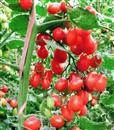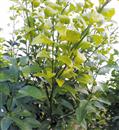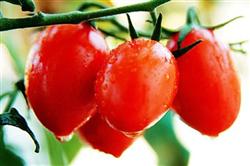Cherry tomato planting: how can virgin fruit be planted with high yield?

How can virgin fruit be planted with high yield? What do you need to pay attention to when planting virgin fruit? Also ask experienced netizens to help introduce that virgin fruit is a very good health and nutrition food, especially suitable for people to pursue the trend of natural and health. And the appearance of the virgin fruit is exquisite and lovely, with high sugar content, about 7-8 degrees, sweet and delicious taste and unique flavor, and it can be cultivated all the year round in our country. Therefore, the farming network has sorted out the steps of planting virgin fruit, which are listed in detail below for netizens' reference. Step 1, the planting period of virgin fruit: the cultivation season of virgin fruit is similar to that of common tomato. For open field cultivation, spring sowing can raise seedlings in the protected field in February, plant after the final frost in late April, and enter the harvest period in the middle and late June. Autumn sowing can raise seedlings in July, plant in August, and start harvesting in October. Cultivation in protected areas can be appropriately early or delayed. Step 2, the seedling method of the virgin fruit: 1. The preparation of the virgin fruit seedling bed: the seedling bed should be selected in the plot where the solanaceae vegetables have not been planted, the fertile fields should be mixed with 40%, 50% mature organic fertilizer, and 1 kg of superphosphate and 5-10 kg of plant ash should be mixed in each cubic meter of nutritious soil, sifted and laid on the seedling bed. The seedling bed should be set in the greenhouse in early spring, the electric hotline should be laid if the temperature is too low, and the seedling bed should be set in a cool and ventilated place in summer. There are many Rain Water in summer, the nursery bed should have rain shelter facilities, and the bed end should have drains. 2. Seed treatment methods of virgin fruit: the diseases of virgin fruit are mostly transmitted by seeds, so seeds should be disinfected before sowing. In order to prevent the occurrence of virus disease, trisodium phosphate is used to disinfect it in production. The method is as follows: first, wet the seeds with clean water, wrap them with gauze, soak them in 10% trisodium phosphate solution for 15-20 minutes, take out the seed bags, wrap them with warm towels and put them at 28 ℃ to accelerate germination. During the period of germination, the seeds were washed once a day, and the seeds could be sown when the seeds were white in about 3-4 days. 3. The sowing method of the virgin fruit: the seedling bed of the virgin fruit must be watered first, and the watering can be smaller when sowing in early spring. In summer, the seeding bed should be filled with enough water, and after the water seeps down, the seeds should be evenly sown, and then covered with 1 cm of sifted soil. Seed 3-5 grams per square meter of seedling bed, 6-8 square meters of seedling bed per mu of planting area. 4. Management of virgin fruit seedlings: heat preservation should be paid attention to in early spring, the ground temperature of seedling bed should be controlled at 25-30 ℃ before emergence, and rain and cooling should be protected in summer. When most of the seeds emerge, the temperature should be cooled in time, and the temperature should be controlled at 20 ℃ during the day and 12-15 ℃ at night. When the seedlings grow 2 true leaves, the seedlings are divided. 5, virgin fruit seedling method: where the temperature in early spring is getting higher, the seedling bed generally does not need to lay a hot line. Early spring seedling should be carried out in sunny morning, using the method of dark water planting, first open a ditch, and then watering, wait for the water to seep down, release the seedling and bury the soil. After being buried, there is no muddy water on the surface. The row spacing is 10 × 10 cm. Summer seedling separation is carried out in the evening or cloudy days, the method is the same as that in early spring. The row spacing is 10 × 10 cm. Irrigation after planting, sunshade on the border, remove the mulch after slowing down the seedlings. The temperature of seedling separation bed was 25-28 ℃ in daytime and 15-18 ℃ in night before seedling retardation, and 20-25 ℃ in daytime and 13-15 ℃ in night after seedling retardation. It is not watered in early spring, and the seedbed is often watered in summer. The seedlings were planted when they reached 8 true leaves. Step 3, the planting method of virgin fruit: the virgin fruit must be prepared before calibration, and 5000 kg of rotten organic fertilizer, 20 kg of N, P, K ternary compound fertilizer and 20 kg of superphosphate should be applied per mu. After leveling the ground, make a flat bed 150 cm wide (if you buckle plastic film in early spring, you will do 10 cm high, 50-60 cm wide). The flat beds were planted in 3 rows, and the small and high beds were planted in 1 row. The distance between plants is 20-30 cm and 4500-6000 plants per mu. Buckle the plastic film to cover the whole border first, and then set the planting hole according to the plant distance, and the planting depth is 1 cm from the cotyledon to the ground. Step 4, daily management of the virgin fruit: 1. Watering the virgin fruit: the virgin fruit is fully watered until the first panicle blossoms and sits without watering. If the planting water is less, it can be ditched in the border and carried out in the morning on a sunny day. The first panicle flower was watered with water for the first time after setting fruit, which required a large amount of water in the fruiting period, watering every 5-6 days. Reduce watering during harvest to prevent fruit cracking. 2. Topdressing of virgin fruit: 10 kg of N, P and K compound fertilizer per mu was applied in combination with watering in the first ear of virgin fruit, and 10 kg per mu of compound fertilizer was applied when the first ear changed color, so as to promote fruit development. After that, topdressing was applied once for every 2 ears of fruit, and the amount of topdressing was 10 kg per mu. 3. Temperature requirements of virgin fruit: the cultivation temperature of virgin fruit is higher than that of ordinary tomato, which is more than 10 ℃ at night, 20-25 ℃ in daytime, and the highest is no more than 35 ℃. 4. Pruning method of virgin fruit: the plants of virgin fruit are generally very tall and erect, and they are inserted into a frame to prevent lodging when the plant grows to 50 cm. Lateral branches have strong growth power, generally double-stem pruning, leaving 2 strong branches first, and erasing the others. Generally do not hit the top, when the lower old leaves yellowed off in time to reduce nutrient consumption. 5. The method of thinning flowers and protecting fruit of virgin fruit: if poor pollination is easy to fall flowers when the temperature is low in early spring, 24-D can be used to smear the newly opened calyx and stalk (only once). The virgin fruit blossoms and bears more per panicle. 20-30 fruits with good fruit setting are selected, and the rest are removed. Step 5, the method of harvesting the virgin fruit: when the virgin fruit is fully ripe, the sepals and a stalk should be retained. Step 6, pest control of virgin fruit: common diseases are early blight, late blight, virus disease, Botrytis cinerea and so on. Control method: rotation with non-Solanaceae crops for 3-4 years. At the initial stage of the disease, 70% mancozeb 500 times solution and 75% chlorothalonil 600 times solution were used, once every 7-10 days, and 4-5 times continuously. Insect pests are mainly aphids, which can be controlled by 2000-3000 times of 20% fenvalerate EC and 2000-3000 times of aphid fog. Planting Environment of Cherry Tomato
- Prev

How to prevent and cure orange yellow dragon disease with granulated sugar?
What is sugar orange dragon disease? How to prevent and cure orange yellow dragon disease with granulated sugar? Also ask netizens with experience to help introduce sugar orange yellow dragon disease, also known as yellow tip disease, is an important disease on citrus, the main plant quarantine objects in China, can destroy the whole orange tree. Therefore, the farming network sorted out the harm and control of yellow friendship disease to sugar orange.
- Next

How is the environment suitable for growing cherry tomatoes?
How is the environment suitable for growing cherry tomatoes? Please also know the netizens to help introduce the cherry tomato fruit bright red meat tender, high sugar content, unique flavor, cool and delicious, can promote thirst, stomach stagnation, rich in a variety of vitamins advantages, farming network sorted out the growth habits of cherry tomato, the following details.
Related
- Moge, come on! The staff of the peasant association in the producing area of cantaloupe were frightened when the crowd gathered.
- Causes and Solutions of low Fruit setting rate of Apple
- Symptoms and control measures of passion fruit virus disease
- Fruit growing lesson: how do apple orchards keep high yields?
- Can you build orchards in the mountains? What are the pros and cons?
- How to manage the coloring period of Crisson grape?
- This paper introduces the processing technology of two kinds of fig products.
- How much is a month for retired teachers in rural areas by 2020?
- How can strawberry planting increase sugar content? We should pay attention to management in many aspects.
- What are the cultivation techniques on how to improve the yield of golden fruit?

